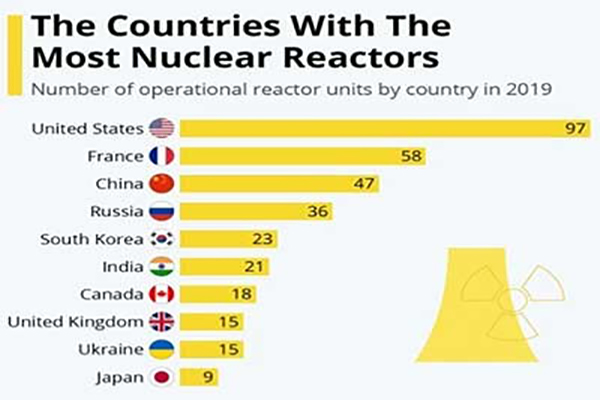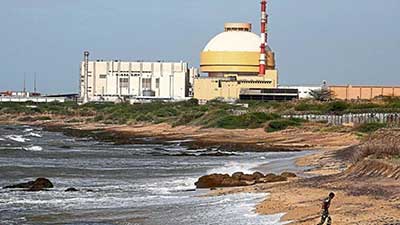Date: 05/05/2023
Relevance: GS-3: Science and Technology- developments and their applications and effects in everyday life.
Key Phrases: uranium-235, nuclear fission process, Central Electricity Authority, Liability Law, Tariff Policy, Nuclear Power, Small Modular Reactors, Civil Liability for Nuclear Damage Act, 2010.
Context:
- The need to address the risks posed by climate change has resulted in efforts to increase the production of renewable energy sources such as wind and solar power to achieve the net zero goal.
- However, it is important to also take into account the potential contributions that nuclear power can make towards this objective.
- The government has recently announced that NTPC will collaborate with NPCIL through a joint venture (JV) and will set up 4.2GW of combined nuclear power capacity at two sites in India by 2035.
How Power is Generated Through Nuclear Power?
- Nuclear power is generated through a process called nuclear fission, which involves splitting the nucleus of an atom into two smaller nuclei.
- This process releases a large amount of energy in the form of heat, which is then used to generate electricity.
- To generate nuclear power, uranium-235 is typically used as the fuel. Uranium-235 atoms are bombarded with neutrons, which causes them to split into two smaller atoms and release more neutrons in the process. These released neutrons can then go on to collide with other uranium-235 atoms, causing them to split as well in a chain reaction.
- The heat generated by the nuclear fission process is used to boil water and produce steam, which then drives turbines connected to generators.
- The generators convert the mechanical energy from the turbines into electrical energy that can be used to power homes and businesses.
Key Highlights:
- Nuclear power shares currently 3% of total electricity in India.
- Although Germany has shut down its last reactors, other advanced countries are working to scale them up.
- France relies on nuclear energy for about 70% of its power and expects to continue at this level.
- The US gets 20% of its electricity from nuclear power and this could increase in the future.
- The UK, South Korea and even Japan—the site of the 2011 Fukushima accident—are planning to increase the share of nuclear power in their electricity mix.
- The Central Electricity Authority recently estimated the capital cost of nuclear power plants at 2.5 times that of coal-based plants (though there are fuel savings that offset some of this differential).
- China is targeting a 10% share of nuclear power in its energy mix by 2035.
- If we were to target the same share by 2040, then considering the additional power demand on account of electrification—a key element of the energy transition—our nuclear power capacity would have to expand from 6.8GW today to around 65GW.
- Our current target is only to have 22.5GW capacity by 2031.

Policy Framework and regulatory challenges that have limited the Growth of nuclear power in India:
- Liability Law:
- The CLNDA (Civil Liability for Nuclear Damage Act) holds the operator of a nuclear plant responsible for any damage caused, even if they are not at fault. This means that they have strict and no-fault liability.
- Tariff Policy:
- The tariff policy in India does not reflect the true cost of nuclear power generation. This is because the government provides subsidies for other sources of energy such as coal and oil.
- The subsidies make it challenging for nuclear power to compete on a level playing field with other energy sources.
- Public Opposition:
- There has been significant public opposition to nuclear power in India, primarily due to safety concerns.
- This opposition has made it challenging for the government to build new nuclear power plants and expand existing ones.
- Regulatory Framework:
- India has a complex regulatory framework that can be challenging to navigate for foreign investors.
- This complexity can make it challenging to obtain the necessary permits and approvals required to build new nuclear power plants.
- Financing Challenges:
- Financing new nuclear power plants can be challenging since they are capital-intensive projects that require significant investment.
- It can be challenging to secure funding for these projects, especially when there are uncertainties around the regulatory framework and liability issues.
Nuclear Power vs Renewable Energy vs Coal-based Power
- Nuclear Power:
- Costs:
- High upfront capital costs for building and maintaining nuclear power plants.
- Strict regulatory requirements for safety and security, which can also add to the costs.
- Concerns over nuclear waste disposal and potential accidents, which can have significant environmental and health impacts.
- Benefits:
- Nuclear power is a low-carbon energy source and can help India reduce its greenhouse gas emissions.
- Nuclear power provides a reliable source of baseload power, which is necessary for meeting the energy demands of a growing economy.
- Nuclear power plants have a long lifespan and can operate for up to 60 years or more, providing stable energy supply over a long period of time.
- Costs:
- Renewable Energy:
- Costs:
- The upfront capital cost of building renewable energy infrastructure is often higher than that of fossil fuel-based power.
- Renewable energy is often dependent on weather conditions, and intermittent power supply can be a challenge.
- Some renewable energy technologies require large amounts of land, which can cause environmental concerns and land-use conflicts.
- Benefits:
- Renewable energy is a clean source of energy that does not emit greenhouse gases, making it an effective solution for addressing climate change.
- Renewable energy sources can be found in abundance in India, such as solar power and wind power.
- Renewable energy can help India reduce its reliance on fossil fuels, which are often imported and subject to price volatility.
- Costs:
- Coal-based Power:
- Costs:
- Coal-based power is a significant source of air pollution, which has significant environmental and health impacts.
- Coal mining and transportation can have significant environmental impacts, including land degradation and water pollution.
- India is heavily reliant on imported coal, which can make the cost of electricity generation dependent on global coal prices.
- Benefits:
- Coal-based power is often cheaper than other sources of electricity, making it a cost-effective solution for meeting India's energy needs.
- Coal-fired power plants can be built quickly, providing a fast solution for meeting India's growing energy demands.
- India has significant coal reserves, which can provide long-term energy security and help reduce dependence on imported oil.
- Costs:
Way Forward:
- Allow private players to enter the nuclear power sector:
- Currently, nuclear power stations in India can only be run by public sector undertakings (PSUs).
- Allowing private players to enter the sector can bring in both technology and capital, which can help reduce implementation times and lower costs.
- Encourage the use of Small Modular Reactors (SMRs):
- SMRs represent a new technology that can reduce costs by enabling the prefabrication of reactor units in factories, which would yield scale economies.
- SMRs could also be installed in existing sites of coal-based power plants that are to be phased out in the country’s transition to net zero.
- Explore partnerships with foreign companies:
- Allowing JVs with foreign companies with technology would allow India to explore the possible involvement of French and Japanese firms in setting up nuclear power plants in India.
- South Korea, in partnership with US firms, is commercializing SMRs, which are typically under 300MW in capacity.
- Provide financing from a combination of bilateral official credit and
loans from sovereign wealth funds:
- Public-private partnerships would involve some investment by the public sector, but there could be substantial additional financing from a combination of bilateral official credit and loans from sovereign wealth funds.
- The International Finance Corporation could be an important source of such credit.
- Amend the Civil Liability for Nuclear Damage Act, 2010:
- The Act extends liability to suppliers of nuclear equipment in case an equipment failure leads to a disaster.
- This is not in line with current international practice where the liability is strictly limited to the operator, and which can be covered. Amending the Act can encourage the entry of private players in the nuclear power sector.
Conclusion:
- While the expansion of nuclear power in India is necessary to meet the net zero target, it should be done in a manner that is safe, cost-effective, and environmentally sustainable.
- Allowing private players, exploring new technologies such as SMRs, and partnering with foreign companies are some of the steps that can be taken to achieve this.
- Additionally, it is crucial to have strong institutional arrangements and regulatory oversight to ensure safety and compliance with international standards.
Source: Live-Mint
Mains Question:
Q. Examine the policy framework and regulatory challenges that have limited the growth of nuclear power in India. (150 Words).








